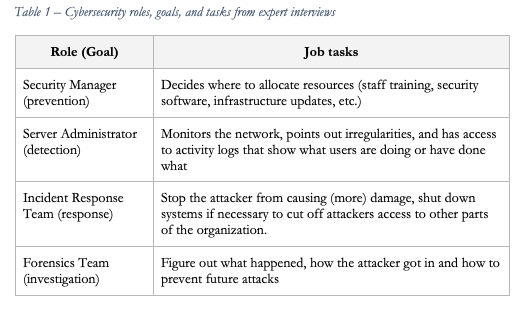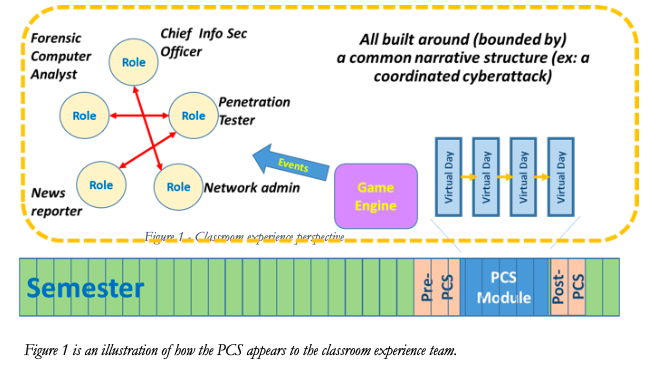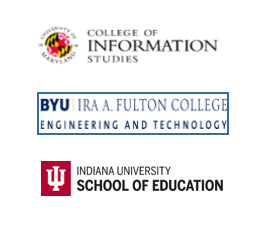Moving into Analysis, Getting Ready for Design
From September into October, the team across the three institutions began to do some important analysis that will help in the upcoming design process. Two teams that were very active were the Expert Research Team that began conducting interviews of cybersecurity experts from municipal and other organizations to understand the kinds of situations that they encountered and the Games Research Team that started looking at—and playing—various games to understand about carious design and mechanics options that could be used in the design of this project’s PCS. A third team – Classroom Experience—began meeting and planning as well.
The Graduate Student Working Group
Across the three institutions are now seven graduate students from doctoral and master’s programs. The project has a commitment to supporting the career development of the students working on it, and this group we hope will provide a professional community for writing projects and forming connections that will help future scholars in their careers. The group will meet for a whole day during the Fall Design Workshop to discuss expansive framing and paper/poster projects.
Planning for a Fall Design Workshop November 22
During the project kickoff meeting, we planned to have a meeting in the fall that would include some of the BYU people who were not able to make it for the summer session. Because Jon Balzotti of BYU is planning to be in Washington DC for a conference on November 23, we have organized a small design workshop to be held at the UMD iSchool on November 21-22. On the 21st, the graduate students will meet as a group to review situative learning models and expansive framing with Dan Hickey. They will then discuss in small groups possible paper projects that we hope that they can co-author. On the 22nd, we will have an all-day design workshop that will begin with presentations by the Expert Interview and Games Research groups and then will have the remaining participants.
Expert Interview Team: Informing the Narrative Design
The Expert Interview Team has worked with members from BYU and UMD to interview leaders in cybersecurity to understand different roles and events which would be realistic scenarios to present the students. The roles are important since the students in the study will be grouped into teams where they will take on the identity of a STEM professional in the game context.

This team developed a fieldnotes process that summarized each interview, and these notes are then analyzed for emergent themes and roles. Some possible roles identified for the cybersecurity module are Security Managers, Server Administrators, Incident Response Teams, and Forensics Teams. Each of these roles can have a different orientation and set of jobs, as described in Table 1. This table shows a snapshot of ongoing analysis that will likely see several iterations before the final narrative is constructed.
Research Team: Looking for Examples
The Games Research Team has been meeting weekly since late September with a goal to find a number of games with mechanics similar to the ones the project envisions. While board games like Pandemic and XCOM the Board Game were an initial inspiration for this project, as we looked closer into the mechanics of those games we found them to lack a depth that captured the kind of involving role-based collaboration in the context of STEM professions we saw as needed for this project. Initial searches for games that were similar on several dimensions revealed a scarcity of games similar to what this project proposed. Rather than a genre that we can add to, the project finds itself looking at a range of games to find different elements that might relate to this project’s platforms. This group then looked at a number of games, playing many, and analyzing their designs to provide the teams working on the design cybersecurity and the crisis response versions of the PCS. The games they reviewed included digital and board games. There are six different dimensions that these games were analyzed based upon:
1. World and map features
2. Roles and role superpowers
3. Asset resources (things to collect and/or protect)
4. Tools (things that do things)
5. Player-asset relationships (ex: inventory/responsibility)
6. Turn and move structure (individual/group)
7. Achievement
This process of analysis is ongoing. As the Games Research Team winds down its initial analysis effort in preparation for the design activities, its members will work on areas of the design of the PCS narrative for this project.
Classroom Experience Team: Planning for the Enactments
The classroom experience team began meeting to discuss the process of embedding the PCS in a specific class where it could be used for grading activities. This team is responsible for the activities that precede and follow the PCS in the classroom, including tests, assessments, and assignments. This team developed an initial proposal for roles and activities that will be evaluated by the PCS design teams.
Figure 1 is an illustration of how the PCS appears to the classroom experience team. While the PCS exists within a virtual calendar with events that the players respond to do, for this team, the PCS is embedded within a semester, and there will be pre and post PCS activities that this team is responsible for developing and integrating with the classroom work, including grades. This team will often play a responsive role to the design teams that will develop proposed approaches that this team will respond to in consultation with the pilot teachers.

Asking Design Questions
As the project moves forward already some important design questions are emerging. Some that the team is considering in the designs are:
1. Approach to turns: Will the team-based PCS in this project have sequential or simultaneous turns? Sequential turns are more consistent with board games. Simultaneous turns may be more realistic and present more collaborative opportunities but maybe a more challenging to design.
2. Collaboration tasks: What kinds of task structures will invite or shape collaboration?
3. Role distribution in teams: Will each member of a team have a different role or will there be multiples of particular roles?
4. Range of player move types: What different kinds of moves/actions do we envision for players.
a. Resource allocation such as moving responders to a location (by role)
b. Researching and finding other information hidden in the PCS
c. Translating information from specialized to general language
d. Reviewing other team players’ choices and concurring/dissenting from the decision.
e. Others?
5. Scenario length: How many different types of moves per role do we envision for the PCS? How might this compare with board games like Pandemic and XCom the board game?
6. Move choices: What does the literature on games suggest would be a large or normal number of move choices per turn and how might this influence our design?
7. Cybersecurity story arc: Will the story arc of a cybersecurity curriculum be based on a single attack or multiple attacks?
8. Game event notification: How will players be notified of in-game events? Will they have a dashboard similar to earlier PCS designs?
9. Player/role information: Do all players on one team see the same information or will students playing different roles have access to information specific to their roles?
10. Specialized role-specific moves: Do players have the same moves of specialized moves as per players’ task? What happens to the team task?
11. Moving economy: What will be the moving economy of every role? Do stronger roles have fewer actions or do stronger actions take up more moves?
12. Differentiated incentives for roles: What happens to collaboration, if we give differentiated incentive to a player than the team, a narrative similar to Golden Ball game show.
The design questions are evolving. They show, however, the range of issues that the design team is beginning to contend with as they shift from a single-player PCS to a multiplayer version with collaboration moves.
Careers In Play Leadership Team
Phil Piety, PhD. University of Maryland iSchool (PI and Learning Analytics). ppiety@umd.edu
Beth Bonsignore PhD. University of Maryland iSchool (Co-PI and Design-based Research), ebonsign@umd.edu
Derek Hansen, PhD.Brigham Young University (Co-PI and Game Technology). dlhansen@byu.edu
Dan Hickey, PhD. Indiana University School of Education (Co-PI, Learning Theory and Assessments). dthickey@umd.edu
